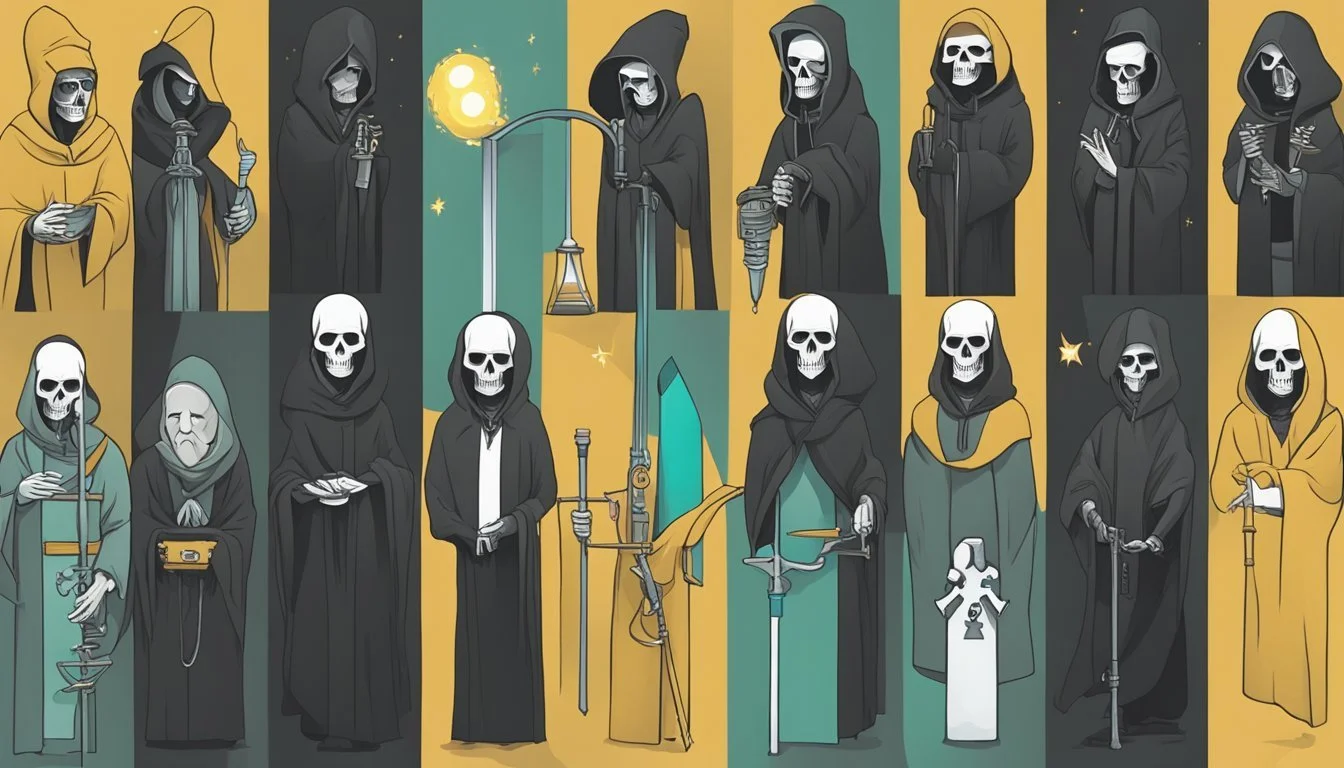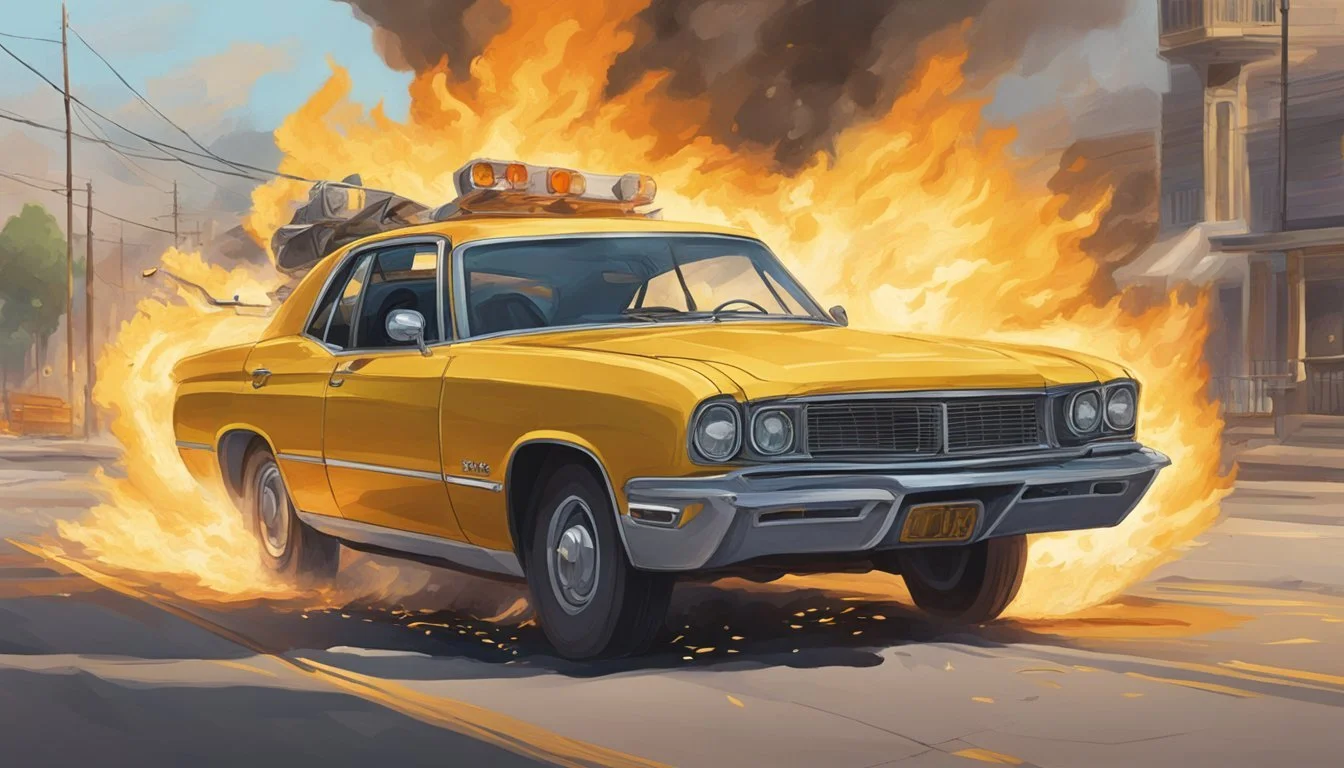8 Breaking Bad Characters' Endings: Ranked from Worst to Best
A Definitive Analysis
Breaking Bad captivated audiences with its gripping narrative and complex characters. The award-winning series followed Walter White's transformation from a mild-mannered chemistry teacher to a ruthless drug kingpin, alongside a cast of memorable personalities whose fates became intertwined with his criminal empire.
The show's finale wrapped up numerous character arcs, providing varying degrees of closure and justice for its diverse ensemble. From tragic downfalls to bittersweet triumphs, the endings for Breaking Bad's key players left lasting impressions on viewers. This article examines eight of the most significant character conclusions, ranking them from least to most satisfying.
1) Todd Alquist: Desert Demise
Todd Alquist's ending in Breaking Bad stands out as one of the most fitting for a character. His death occurs during the dramatic finale in the desert.
Jesse Pinkman, who suffered greatly at Todd's hands, ultimately strangles him with his handcuff chain. This act of revenge brings Jesse's arc full circle and delivers justice for Todd's numerous crimes.
Todd's demise is particularly satisfying given his actions throughout the series. He murdered an innocent child witness and kept Andrea as leverage against Jesse. His polite demeanor contrasted sharply with his cold-blooded nature.
The desert setting of Todd's death mirrors the harsh, unforgiving world he operated in. It serves as a stark reminder of the consequences that come with a life of crime and violence.
Todd's ending ranks low on this list due to its poetic justice. His death marks the end of a character whose actions significantly impacted the course of the show's final seasons.
2) Lydia Rodarte-Quayle: Ricin in the Stevia
Lydia Rodarte-Quayle's fate in Breaking Bad was sealed with a packet of poisoned Stevia. As a high-ranking executive at Madrigal Electromotive, Lydia played a crucial role in the drug empire's operations.
Her paranoia and ruthlessness made her a formidable antagonist throughout the series. Lydia's willingness to order murders and manipulate others for personal gain showcased her dangerous nature.
In the series finale, Walter White exacted his revenge by slipping ricin into Lydia's Stevia packet. This method of poisoning was particularly fitting, given Lydia's habitual use of the sweetener in her tea.
The ricin poisoning ensured a slow and painful death for Lydia, mirroring the calculated and meticulous nature of her own actions throughout the show. Her demise served as a final demonstration of Walter White's strategic brilliance.
Lydia's ending solidified her place as one of Breaking Bad's most memorable villains. Her death brought closure to her character arc and demonstrated the consequences of her actions in the criminal underworld.
3) Hector Salamanca: Bell-Tolling Finale
Hector Salamanca's ending in Breaking Bad was both shocking and poetic. The once-fearsome cartel boss spent his final years confined to a wheelchair, unable to speak or move.
Despite his physical limitations, Hector maintained his fierce hatred for Gus Fring. This animosity ultimately led to his memorable demise.
In a plot orchestrated by Walter White, Hector agreed to meet with his longtime enemy Gus. Unbeknownst to Gus, Hector's wheelchair was rigged with a bomb.
As Gus approached, Hector activated the explosive using his signature bell. The resulting blast killed both men instantly, bringing their long-standing feud to a dramatic close.
Hector's final act was a perfect encapsulation of his character. Even in death, he remained defiant and vengeful, using the very bell that had become his voice to exact his revenge.
This ending provided a fitting conclusion for one of Breaking Bad's most memorable antagonists. It showcased Hector's unwavering resolve and allowed him a final moment of triumph.
4) Jack Welker: Quick Retribution
Jack Welker's demise in Breaking Bad was swift and merciless. As the leader of a neo-Nazi gang, Jack became Walt's final adversary in the series.
His end came during the intense showdown at the compound. Walt's automated machine gun contraption unleashed a barrage of bullets, cutting down Jack and his crew.
In his final moments, Jack attempted to bargain for his life by offering information about Walt's stolen money. However, Walt showed no interest in negotiations.
Without hesitation, Walt shot Jack mid-sentence, mirroring how Jack had previously killed Hank. This act of retribution brought a sense of poetic justice to the series.
Jack's quick and unceremonious death served as a fitting end for a character who represented pure malevolence. It provided closure for Walt's arc and satisfied viewers' desire for vengeance against one of the show's most despicable villains.
5) Gustavo Fring: Explosive Exit
Gustavo Fring's demise in Breaking Bad was nothing short of spectacular. The drug kingpin met his end in a carefully orchestrated explosion at the Casa Tranquila nursing home.
Walt's ingenious plan involved rigging Hector Salamanca's wheelchair with a bomb. When Gus visited Hector to gloat, he unwittingly sealed his own fate.
The explosion left half of Gus's face obliterated, revealing his skull underneath. In a final display of his composed demeanor, he calmly adjusted his tie before collapsing.
This unforgettable scene showcased the show's masterful blend of shocking violence and dark humor. It also marked a pivotal moment in Walt's transformation into Heisenberg.
Gus's death was a fitting end for such a formidable adversary. It demonstrated the lengths Walt would go to protect himself and eliminate threats to his empire.
The explosive exit of Gustavo Fring remains one of Breaking Bad's most iconic and memorable moments. It perfectly encapsulated the character's duality - outwardly calm and collected, yet capable of extreme violence.
6) Jane Margolis: Tragic Overdose
Jane Margolis' death marked a pivotal moment in Breaking Bad. As Jesse Pinkman's girlfriend and landlord, Jane played a significant role in his life and the overall story arc.
Jane's relapse into drug addiction alongside Jesse led to her eventual demise. Her overdose occurred while Walter White was present, and his decision not to intervene sealed her fate.
The consequences of Jane's death rippled throughout the series. Jesse was devastated, experiencing intense guilt and grief that altered his outlook on life.
Jane's father, an air traffic controller, was so distraught by her loss that his negligence at work led to a tragic plane collision. This event further emphasized the far-reaching impact of her death.
Her passing also deepened the rift between Jesse and Walt, as Jesse remained unaware of Walt's role in her demise. This secret became a significant source of tension in their relationship.
Jane's character and her tragic end served as a catalyst for major plot developments and character transformations in Breaking Bad. Her story highlighted the devastating effects of addiction and the unintended consequences of characters' actions.
7) Walter White: Lab's Last Stand
Walter White's final moments unfold in a meth lab, bringing his journey full circle. After ensuring his family's financial future, he returns to the criminal world one last time.
In the lab, Walt finds a sense of peace. He admires the equipment, running his hand over the surfaces. This gesture symbolizes his connection to the empire he built and lost.
Walt's demise comes from a bullet wound sustained earlier. As police sirens approach, he collapses on the lab floor. His last breath is taken surrounded by the tools of his trade.
This ending provides closure for Walt's character arc. He dies on his own terms, in a place that represents both his greatest achievements and deepest regrets.
Walt's final moments in the lab encapsulate his transformation from high school teacher to drug kingpin. It serves as a fitting conclusion to his complex and morally ambiguous story.
8) Skyler White: Witness Relocation
Skyler White's fate at the end of Breaking Bad remains somewhat ambiguous. After Walt's death, she likely entered witness protection with her children, Holly and Walt Jr.
This outcome provided Skyler with a fresh start away from the criminal world she was unwillingly pulled into. It allowed her to escape the scrutiny and judgment associated with her husband's notorious activities.
Witness relocation offered Skyler and her family a chance at anonymity and safety. They could build new lives free from the shadow of Heisenberg's legacy.
While not explicitly shown on screen, this ending for Skyler aligns with the series' themes of consequences and redemption. It gives her character a path forward after the turmoil and trauma she endured.
The witness protection scenario also ties up loose ends regarding Skyler's legal situation. It suggests she cooperated with authorities in exchange for immunity and a new identity.
Character Development and Arcs
Breaking Bad's characters undergo profound transformations, driven by complex motivations and facing dire consequences for their actions. The show masterfully portrays the evolution of its cast, revealing hidden depths and unexpected turns.
Complexity of Character Transformations
Walter White's transformation from a meek chemistry teacher to a ruthless drug lord stands as the centerpiece of Breaking Bad's character development. His gradual descent into villainy showcases the show's nuanced approach to character arcs.
Jesse Pinkman evolves from a small-time dealer to a skilled chemist and eventual moral compass. His journey highlights the series' ability to subvert expectations and create multifaceted personalities.
Skyler White's arc moves from oblivious housewife to complicit partner, demonstrating the show's commitment to developing supporting characters alongside the protagonists.
Hank Schrader's progression from boisterous DEA agent to determined investigator adds depth to his character, making his fate all the more impactful.
Motivations and Consequences
Walter White's initial motivation of providing for his family after his death drives his early decisions. As the series progresses, his actions reveal a deeper desire for power and recognition.
Jesse's quest for acceptance and purpose continually shapes his choices, leading to both growth and tragedy. His relationships with Walt, Jane, and Andrea illustrate the consequences of his evolving motivations.
Skyler's protective instincts for her family conflict with her growing awareness of Walt's criminality. This internal struggle results in complex decisions and moral compromises.
Saul Goodman's self-preservation instinct guides his actions, ultimately leading to his dramatic transformation into Gene Takavic in the spin-off series Better Call Saul.
Thematic Significance
Breaking Bad's character endings reflect key themes of moral decay and consequences. The fates of different characters illuminate the show's exploration of ethics, choice, and transformation.
Moral Ambiguity
Walter White's descent into villainy exemplifies the show's central theme of moral ambiguity. His journey from mild-mannered teacher to ruthless drug kingpin blurs the lines between right and wrong. Jesse Pinkman's arc moves in the opposite direction, showing potential for redemption.
Other characters like Hank Schrader and Skyler White are caught between conflicting loyalties and ethical dilemmas. Their endings highlight the difficult choices forced upon them by Walt's actions.
The fates of minor characters like Jane Margolis and Gale Boetticher serve as turning points that push Walt further into darkness. These deaths underscore how small decisions can have major moral repercussions.
Impact on Storytelling
Breaking Bad's character endings drive the narrative forward in powerful ways. Walt's transformation is the backbone of the entire series, with each choice leading inexorably to his ultimate fate.
Jesse's ending provides a counterpoint to Walt's, offering a glimmer of hope amidst the bleakness. This contrast enriches the overall story and adds emotional depth.
The demise of antagonists like Gus Fring and the neo-Nazis creates narrative tension and satisfaction. These endings mark key plot milestones and shift the balance of power.
Supporting character fates, such as Hank's tragic death and Skyler's isolation, raise the stakes and intensify the drama. They illustrate the far-reaching consequences of Walt's actions on those around him.









